
 What's on this page: What's on this page:
What is the temperature?
Markets and Fairs
Places to visit
Chiclana
Novo Sancti Petri
Cadiz
Jerez
Alberto Doran Zoo, Jerez
Bolonia & Baelo Claudia
Gibraltar
Ceuta
Tangier
Medina Sidonia
Restaurants

From Tarifa, the most southerly point of Europe, the Costa de la Luz – ‘coast of light’ – runs westwards to Cádiz and beyond to the border with Portugal. This Atlantic shoreline is preferred by the Spanish themselves, but the generous beaches mean there is sand to spare.
 On this coast you can indulge yourself – you haven’t lived until you’ve feasted on Sanlucar de Barrameda’s giant prawns, fresh tuna from Conil or been on safari in the Doñana National Park’s bush land. This is birdwatchers paradise, home to black kites and where white spoonbills from Africa come to breed each year. Alternatively, head inland, past the giant silhouettes of Osborne’s bull and Sandeman’s señor, which mark the sherry vineyards and the bodegas of Jerez. On this coast you can indulge yourself – you haven’t lived until you’ve feasted on Sanlucar de Barrameda’s giant prawns, fresh tuna from Conil or been on safari in the Doñana National Park’s bush land. This is birdwatchers paradise, home to black kites and where white spoonbills from Africa come to breed each year. Alternatively, head inland, past the giant silhouettes of Osborne’s bull and Sandeman’s señor, which mark the sherry vineyards and the bodegas of Jerez.

 You can see on the graph this area enjoys a great climate. You can see on the graph this area enjoys a great climate.
The red bars show the average daily high temperature and the blue bars the daily low temperature for each month.
The black line is the average temperature for London, UK.
The weather in the area is temperate, with temperatures varying, on average, between 12°C in the winter months and 32°C in the summer months. The area has little rainfall and over 3,225 hours of sunshine annually, making Chiclana one of the sunniest places in Spain.
The average sea temperature is 17°C.

Click on this icon for an up to date weather forecast.

Each town in Andalucia boasts its own local market. Bringing colour and a chance to find that holiday bargin. The table below details some of the more local markets.
| Monday | Cadiz, Jerez | | Tuesday | Chiclana, Chutane, Puerto de Santa Maria | | Wednesday | Rota | | Thursday | San Fernando | | Friday | Conil | | Saturday | - | | Sunday | Seville (Alameda de Hercules) |
Andalucia is also famous for its colourful fairs. Here is a list of the major ones and their dates:
| Seville | Two weeks after Easter | | Jerez | First week in May | | Santa Maria | Second week in May | | San Lucar | Third week in May | | Cordoba | Last week in May | | Algeciras | First week in June | | Conil | First week in June | | Marbella | Second week in June | | Estepona | First week in July | | Los Barios | First week in July | | La Linea | Second week in July | | Huelva | First week in August | | Tarifa | Second week in August | | Baeza | Second week in August | | Malaga | Third week in August | | Tarifa | First week in September | | Ubeda | Last week in September | | Jaen | Second week in October | | San Pedro | Second week in October |


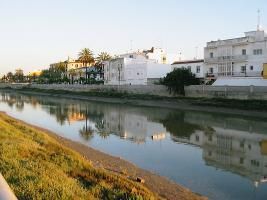 Chiclana de la Frontera, south of the Bay of Cadiz, is the ideal location to discover this unspoilt region. You can visit the historic cities of Cadiz and Seville, discover the Sierras and the enchantment of Moorish Granada, sample the daily fresh produce from the local fishing villages and wine and sherry producing vineyards, and walk along the miles of golden sandy beaches while watching the sunset. Chiclana de la Frontera, south of the Bay of Cadiz, is the ideal location to discover this unspoilt region. You can visit the historic cities of Cadiz and Seville, discover the Sierras and the enchantment of Moorish Granada, sample the daily fresh produce from the local fishing villages and wine and sherry producing vineyards, and walk along the miles of golden sandy beaches while watching the sunset.
Chiclana has something for everyone!
 Chiclana is surrounded by beautiful countryside of stone pine forest, cliffs and the most beautiful, cleanest, sandy beaches in Spain; perfect for sunbathing and relaxing or for pursuing the many water sports activities available, making this area a fantastic, little known, tourist destination. Chiclana is surrounded by beautiful countryside of stone pine forest, cliffs and the most beautiful, cleanest, sandy beaches in Spain; perfect for sunbathing and relaxing or for pursuing the many water sports activities available, making this area a fantastic, little known, tourist destination.
King Alfonso XII granted the city of Chiclana de la Frontera its charter in 1876 but the modern town dates back to 1303 when King Fernando IV gave this uninhabited village to Alonso Pérez de Guzmán "The Good", so that he could colonize it. His successors, the Dukes of Medina-Sidonia (of Armada fame), were Lords of the village until the XIX century.
Chiclana has been continuously inhabited since the 14th century but the village really began to develop with the discovery of America when the production and export of wines began to support the trade with the new world.
The Moorish influence can be seen in the architecture of Chiclana and Andalucia; arches, stucco works and the ornamental use of calligraphy. Following the Christian conquest new churches and palaces were built, many of the buildings created as a hybrid Christian Islamic style known as Mudejar. Later, Gothic styles from northern Europe filtered into Andalucia, though the Mudejar influences survived into the 18th century. In the 16th century, Andalucia was the centre of the Spanish Renaissance; and a uniquely Spanish interpretation of the Baroque emerged in the 18th century.
The second half of the XVIII century saw the town develop further with the construction of many fine buildings, three outstanding examples are:
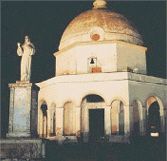 Santa Ana Hermitage, which is, without doubt, one of the most spectacular buildings of Chiclana. At the top of the Santa Ana hill it is visible from miles around. It was built to commemorate the nearby battle between Spanish and French soldiers during the Independence War. It is an octagonal chapel, surrounded by a portico with colonnades, built in the second half of the XVIII century by the brilliant architect Torcuato Cayón. The views from the Hermitage are breath taking. Santa Ana Hermitage, which is, without doubt, one of the most spectacular buildings of Chiclana. At the top of the Santa Ana hill it is visible from miles around. It was built to commemorate the nearby battle between Spanish and French soldiers during the Independence War. It is an octagonal chapel, surrounded by a portico with colonnades, built in the second half of the XVIII century by the brilliant architect Torcuato Cayón. The views from the Hermitage are breath taking.
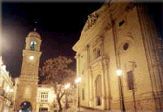 "Arquillo del Reloj" or The Clock Tower in La Plaza Mayor, stands next to San Juan Bautista Church and serves as the bell tower for this beautiful Church. San Juan Bautista church is considered an excellent example of neoclassical art. The architects Torcuato Cayón and Torcuato Benjumeda built it between 1773 and 1814. Of special interest is a part of its “Retable,” made by Roque Balduque in 1552, which is part of the previous church that stood on this site. The Church also houses two pictures from Zurbarán school. "Arquillo del Reloj" or The Clock Tower in La Plaza Mayor, stands next to San Juan Bautista Church and serves as the bell tower for this beautiful Church. San Juan Bautista church is considered an excellent example of neoclassical art. The architects Torcuato Cayón and Torcuato Benjumeda built it between 1773 and 1814. Of special interest is a part of its “Retable,” made by Roque Balduque in 1552, which is part of the previous church that stood on this site. The Church also houses two pictures from Zurbarán school.
In the 18th Century British merchants settled here and laid the foundations of the modern sherry trade. They discovered that the soil, climate and local grapes produced fine wines, particularly if fortified with grape spirit. This connection can still be seen today with companies such as John Harvey remaining in British ownership. Even though wine production has reduced in recent times, Chiclana is still rightly proud of its wine cellars and the excellent wines they produce, continuing a tradition started by the Phoenicians 3000 years ago.

Chiclana’s wines are the ideal accompaniment to a large variety of fresh, local, typical Andalucian cuisine; although Chiclana does claim some of her own unique fish and seafood specialities from Chiclana’s own estuary and tidal pools.
Chiclana is also famed also for ‘chacinas’ (sausage), like ‘butifarra’ and ‘longaniza’ and ‘chicharrones’ (oven roasted pork) and especially its most famous dish: ‘berza’ (cabbage based stew). Another of Chiclana’s specialities are its pastries such as the ‘Tortas de Almendra’ (almond pastries) which are baked exclusively in the Convent of the Augustinian Nuns; the reason why they are locally named ‘Tortas de la Monjas’. There are many restaurants, bars and cafes to sample these local delicacies!
Chiclana is now a modern town of 60,000 people providing a wide variety of services to visitors and locals:
- tourist attractions,
- artisan crafts,
- wine cellars,
- markets with fresh produce,
- bars and restaurants
These all combine to give the city an interesting and relaxed atmosphere.

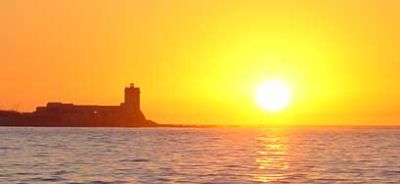
The little island of Sancti Petri, languishing in the Bay of Cadiz, is surrounded by myth. It was here that Hercules completed two of his twelve labours, and the Temple of Hercules was built three thousand years ago. Only parts of the Temple’s foundations remain but Hannibal and Caesar both stayed at the Temple. A church now stands on the site of the Temple. Built at the end of the 18th Century the church was designed by the architects Torcuato Canyon and Torcuato Benjumeda and is the best example of neoclassical architecture in the province.
Today, the historic Sancti Petri Castle stands guard over the Sancti Petri Channel separating Chiclana from Cadiz and San Fernando.
Opposite the Island is 8 kilometres of one of the finest beaches in Spain. This beach is divided into two distinct areas. The first is the water front promenade offering a variety of excellent bars, fine restaurants and shops. The second part of the beach is untouched golden sand, which has achieved the coveted Blue Flag status for cleanliness and water quality.
At the southern end of the urbanisation is Novo Sancti Petri a tourist and sports complex; encompassing Novo Sancti Petri golf course and clubhouse, tennis courts, shopping complex with many boutiques and a horse riding centre.

Opposite the Island of Sancti Petri is a yachting and fishing harbour. From here it is possible to take an excursion to explore the Natural Park of Cadiz Bay.

The varied coastline lends itself perfectly to the whole gamut of water sports, while just inland golf courses have become a major feature of the landscape.
Located within Sancti Petri Harbour is a:
- Marina and Yacht club with 250 moorings with a chandlers and launch and recovery ramp.
- Sailing and windsurfing school.

 Unlike many of Spain's coastal towns Cadiz does not rely on tourism as its prime source of income. Rather it is still a working port with a very relaxed atmosphere, and vibrant night life which explains its popularity as a holiday destination for many Spaniards. Unlike many of Spain's coastal towns Cadiz does not rely on tourism as its prime source of income. Rather it is still a working port with a very relaxed atmosphere, and vibrant night life which explains its popularity as a holiday destination for many Spaniards.
Almost entirely surrounded, by water Cadiz was founded by the Phoenicians in 1100 BC and is steeped in history. Legend links the city’s foundation to Hercules who had to separate Europe from Africa as one of his twelve labours. Hannibal lived in the city and Julius Caesar first held office here. Whatever its origins Cadiz is credited with being the oldest continuously inhabited city in Europe
Thanks to Christopher Columbus, who began two of his major voyages from here, Cadiz became a major trading port, reaching its heyday in the early 16th century as the launching point for the journey to the new world. Cadiz was later raided by Sir Francis Drake, when he “singed the King of Spain’s beard” in a daring raid. In 1812 the country's first Constitution was declared here.
The old city looks quite Moorish and is enchanting with narrow cobbled streets opening on to small squares. Many of the buildings reflect the city's overseas links.

A good starting point for your visit to this intriguing city is the Tourist Information Office in the Plaza San Juan de Dios. where you can pick up excellent guides to all the major places of interest.

Cathedral Nueva: This 18th Century Baroque cathedral, capped by a dome of golden tiles, gets few visitors allowing you a peaceful contemplative visit - a welcome change after the hordes of visitors in places such as Seville. A highlight is the lower floor. If you stand in the middle of the circular basement and make a noise the echo effect it produces is truly wonderful.
The best external view of the cathedral is to walk along the sea front to view the golden dome.
Iglesia de San Felipe Neri: Here parliament gathered in 1812 to proclaim Spain’s first constitution and it was here that the Cortes of Cadiz met when the rest of Spain was subjected to the rule of Napoleon's brother, Joseph Bonaparte.
Oratorio de Santa Cruz: This church is noted for its elegantly decorated upper floor containing some fine Goya paintings depicting the Miracle of the Loaves and Fishes, the Guest at the Wedding and the Last Supper. An excellent free guide is given upon entry.
Gran Teatro, Manuel de Falla: This theatre is set in an impressive neo-Mudejar building which has an impressive interior as well. There is an active programme of events throughout the year.Fine Arts and Archaeology Museum
The Fine Arts museum on the second floor includes a Rubens canvas and an excellent collection of canvasses by Zurbaran.
Torre Tavira: This is the highest and most important of the city's old watchtowers and affords a dramatic panoramic view of the city. A special feature of the tower is its "camera obscura" - a darkened room in which mirrors and lenses are used to project spectacular images of the city onto a screen.
Night Life
Cadiz has a vibrant nightlife consisting of traditional tapas bars, street cafes, all night discos and some wonderful local fiestas. The absence of mass tourism means you can enjoy a really Spanish night out without it costing the earth.
Start your evening with a tour of the tapas bars and sample an appetising array of tasty Andalucian snacks washed down with glasses of the local wines and sherries. Some bars offer a selection of 40 or more hot and cold tapas.
Plaza Mina in the centre and Calle De Manuel Rances are among the liveliest places but practically every street in the city is packed with bars, cafes and restaurants. In the summer, head for the Paseo Maritimo seafront promenade which buzzes with outdoor activity on warm, Andalucian evenings.
Many of the city's most reasonably priced, traditional restaurants are to be found in and around Plaza Juan de Dios near the port. The emphasis is on fresh fish dishes but you'll also see other Andalucian specialties on the menu including gazpacho. As this area is home to Spanish sherry you'll find many meat dishes - lamb and oxtail stews, sautéed steaks, kidneys and tripe - generously soaked in the fortified wines of Jerez.
If dancing is your scene, head for the all night dance venues in the La Punta district where the discos don't really get going until 3am! You can dance till dawn then enjoy warm, fresh churros (crispy, Spanish pastries) with coffee and chocolate sauce for breakfast in La Plaza Flores.
This is a city of Fiestas which go on year round. The biggest and best takes place at the beginning of Lent. This is carnival time all over Spain but Cadiz is famous for having the most spectacular pre-Lent festival in the whole country and thousands of Spaniards head for Cadiz to enjoy a week of street parties, fancy dress parades, outrageous political satire and round-the-clock celebrations.

Jerez is a delightful town famed worldwide as the sherry capital of the world and the cradle of Flamenco.
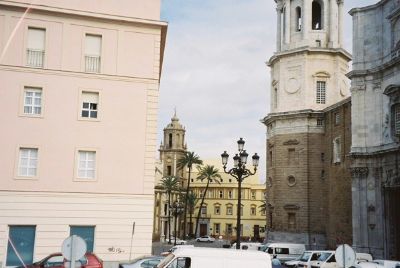
Sherry is one of the most famous wines in the world and it has been appreciated for centuries.
 This region boasts the right combination of climate and soil that give Sherry its distinctive characteristics. Many of its numerous Bodegas provide fascinating tours allowing you a glimpse of the art of making the world’s finest sherry. Three of the best known bodegas are Sandeman, Gonzalez Byass and Domecq – click the name to be taken to the website. This region boasts the right combination of climate and soil that give Sherry its distinctive characteristics. Many of its numerous Bodegas provide fascinating tours allowing you a glimpse of the art of making the world’s finest sherry. Three of the best known bodegas are Sandeman, Gonzalez Byass and Domecq – click the name to be taken to the website.
Sandeman Gonzales Byass
Domecq

But not only Sherry is produced: Brandy de Jerez is noted for its extraordinary quality. controlled by a "Consejo Regulador" which certifies both the quality and the origin. Ripened in oak barrels used for producing Sherry, this Brandy is famous throughout Spain for its unique, subtle flavours. For more information visit http://www.brandydejerez.es/en/
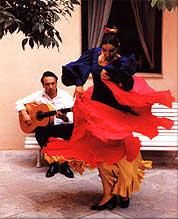
Flamenco:
For more than two centuries Jerez has been famous for being one of the most important cradles of Flamenco recognized by the very best exponents of this art and by flamenco lovers everywhere. Nowadays, Jerez enjoys international prestige as the town of Flamenco. There are more than a dozen small flamenco clubs (peñas flamencas) which frequently house concerts and recitals.
The horses of the "Baja Andalucía" have been admired since ancient times. The excellent pastures in the marshes and excellent climate combine to produce a perfect environment for breeding these horses. The Royal Andalusian School of Equestrian Art was founded in Jerez in 1973 with the aim of preserving and promoting classical horse training. Its headquarters is in El Recreo de las Cadenas, an elegant palace designed by Garnier in the second half of the 19th Century.
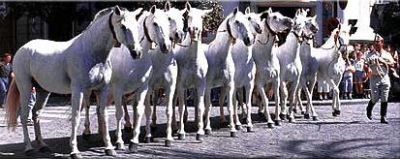
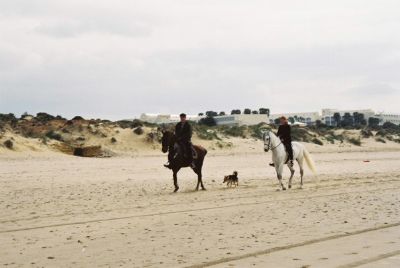
But Jerez is not just Sherry, Brandy, Flamenco and horses: the Bull-fighting Art Museum, the Clock Museum, the Congress Palace and the well respected Zoo can be also explored in this gem of Andalucia.
Jerez Zoo - Alberto Duran
 Jerez zoo and botanical gardens are one of the most interesting in Spain. Its extensive zoological collection has made it the most important zoo in Andalucia. Jerez zoo and botanical gardens are one of the most interesting in Spain. Its extensive zoological collection has made it the most important zoo in Andalucia.
The zoo started when a small collection of animals that arrived to Cadiz harbor without an owner or destination. The animals were temporally placed in the Tempul garden. At that time, Snr. Alberto Duran Tejada, who was in charge of the City Parks and Gardens proposed Jerez set up a zoo and thanks to his tirelss work and lobbying of the city fathers the zoo and botanical garden “ Alberto Duran” opened its doors on 10th February 1953.
A day at Jerez zoo is truly amazing with all the facilities to make your visit unforgettable.
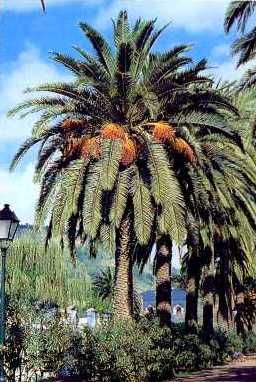 The park is located in the Tempul garden. Dating from 1869, this garden was created around Jerez’s water reservoir. Originally this was a botanical garden, with hundreds of different species from five continents. This tradition has continued with new exotic and indigenous bushes and trees being added to form a collection of almost 400 different species. The park is located in the Tempul garden. Dating from 1869, this garden was created around Jerez’s water reservoir. Originally this was a botanical garden, with hundreds of different species from five continents. This tradition has continued with new exotic and indigenous bushes and trees being added to form a collection of almost 400 different species.
You can walk amongst the trees and contemplate wonderful specimens of Pines, Cedar from the Himalayas, and Araucanian trees as well as the rare examples of Araar, Vignatigo, Jabonero, and Almiz from Mississippi; however most notable is the collection of Palm trees.
Since inception, the number of animals at the zoo steadily increased to the present collection of over 1,300 animals from more than 200 different species from five continents, including the White tiger and her cubs: the only ones in Spain.
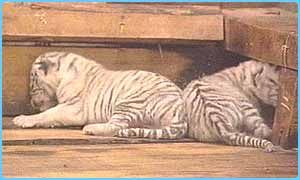 Jerez zoo is noted for conservation work and its collection of endangered species. The zoo works closely with other European zoos on breeding projects to preserve rare species and reintroduce them to their natural habitat. The main focus is protecting indigenous Iberian fauna. This is a great place to see some of the most interesting and endangered European wildlife. Jerez zoo is noted for conservation work and its collection of endangered species. The zoo works closely with other European zoos on breeding projects to preserve rare species and reintroduce them to their natural habitat. The main focus is protecting indigenous Iberian fauna. This is a great place to see some of the most interesting and endangered European wildlife.

 The beautiful unspoilt sandy bay of Bolonia is still a well-kept secret located some 15 km north of Tarifa. The bay is great for families with a safe gently shelving sandy beach. There are hostels and bars giving Bolonia a funky appearance. At the north end of the bay the golden sand forms a huge sand dune, said to be one of the biggest in Europe. Climbing the dune takes you above the tops of the trees in the pine forest on the peninsular giving beautiful views across the bay and looking down the coast towards Tarifa and Africa. The beautiful unspoilt sandy bay of Bolonia is still a well-kept secret located some 15 km north of Tarifa. The bay is great for families with a safe gently shelving sandy beach. There are hostels and bars giving Bolonia a funky appearance. At the north end of the bay the golden sand forms a huge sand dune, said to be one of the biggest in Europe. Climbing the dune takes you above the tops of the trees in the pine forest on the peninsular giving beautiful views across the bay and looking down the coast towards Tarifa and Africa.
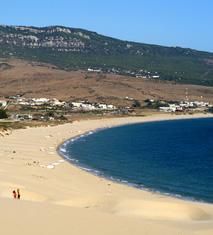 The centre piece of this bay is Baelo Claudia, one of the three most important Roman settlements found in Andalucia. The town developed about 2000 years BC as a maritime link to Tangier. It became an important fish salting (Garum) industrial centre and was thriving at the time of Emperor Claudius (41 -45 AD). The ruins are open to the public and well worth the visit. (Free to EU citizens on production of an ID card or passport.) The centre piece of this bay is Baelo Claudia, one of the three most important Roman settlements found in Andalucia. The town developed about 2000 years BC as a maritime link to Tangier. It became an important fish salting (Garum) industrial centre and was thriving at the time of Emperor Claudius (41 -45 AD). The ruins are open to the public and well worth the visit. (Free to EU citizens on production of an ID card or passport.)
Opening times on Tuesdays to Saturdays, June to September are 10am to 8pm, closing an hour earlier in March, April, May and October. From November to February, the opening hours are 10am to 6pm. Sundays and Holidays the opening time is 10am to 2pm. Like many monuments in Spain, it is closed Mondays and 1 Jan, 6 Jan, 24 Dec, 25 Dec, 31 Dec.
Gibraltar
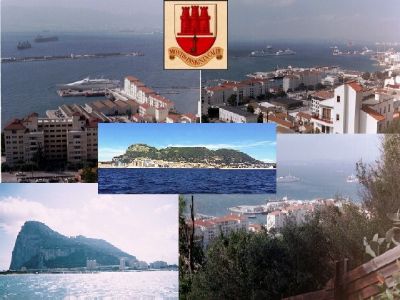
Click on the picture for the Government Tourist Information Site.
One of the Pillars of Hercules, created when he separated the continents of Europe and Africa, the Rock of Gibraltar sits at the southernmost tip of Europe.
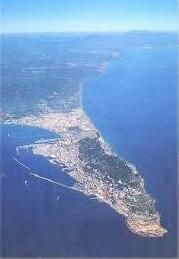
Surrounded by sea on three sides Gibraltar shares a land frontier with Spain and is at the crossroads of the Atlantic Ocean and the Mediterranean Sea. The Strait of Gibraltar is of immense strategic importance and throughout history has played a key part in battles to control the western Mediterranean seaways.
Linked throughout its history with the sea, Gibraltar was the gateway to the invasion of Europe by the Moors in 711AD and is where Lord Nelson was brought after he was shot by the French at the Battle of Trafalgar. For the last 300 years Gibraltar has been a British dependency and has prospered as one of the busiest ports in the Mediterranean.
This spectacular rock covers a land area of about six square kilometres and has five beaches - Catalan Bay, Camp Bay, Eastern Beach, Sandy Bay and Little Bay. Centred around its three marinas, water sports play a large part in life in Gibraltar: Diving, sailing and dolphin watching are widely enjoyed.
Take an official rock tour to introduce yourself to Gibraltar’s treasures. Highlights include:
 St Michael’s Cave: There are over 150 caves inside the Rock. The most famous cave is St. Michael’ Cave which is a dramatic natural grotto rich with stalagmites and stalactites. The cave’s natural auditorium is used for concerts and theatre performances. St Michael’s Cave: There are over 150 caves inside the Rock. The most famous cave is St. Michael’ Cave which is a dramatic natural grotto rich with stalagmites and stalactites. The cave’s natural auditorium is used for concerts and theatre performances.
The Barbary apes' den: There are three troupes of monkeys on the Rock, the only place in Europe where wild Apes can be found. Legend has it that if the apes die out the British will leave the Rock.
The Apes’ Den can be reached by the cable car. The ride takes you to over 1000 feet to the top of the rock where you can take in the breathtaking view of two continents – north, Spain and Europe; south Morocco and Africa.
The Moorish Castle: Dates back to 1160AD when Abd-al-Mummin, Sultan of Morocco who also founded the city of Gibraltar, first fortified Gibraltar. The present Tower of Homage and the Walls you see today were rebuilt in the 14th century, but nevertheless bear the scars of centuries of conflict.
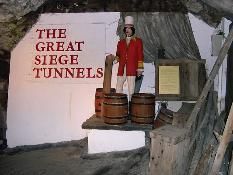 City Under Siege exhibition and the Great Siege Tunnels: City Under Siege exhibition and the Great Siege Tunnels:
This labyrinth of 30 miles of man-made tunnels were excavated by hand during the Great Siege of 1779-83. This exhibition shows you some of the amazing feats of ingenuity devised to defend the Rock from invaders.
In addition, the military occassionally run tours of tunnels closed to the public.
Shopping
 Gibraltar is a British Dependent Territory that is self-governing in all matters except foreign policy. It is a VAT (IVA) exempt jurisdiction that means it is one of the cheapest places in Europe to shop for items such as tobacco, cosmetics, perfumery, spirits, jewellery and electrical goods. Gibraltar is a British Dependent Territory that is self-governing in all matters except foreign policy. It is a VAT (IVA) exempt jurisdiction that means it is one of the cheapest places in Europe to shop for items such as tobacco, cosmetics, perfumery, spirits, jewellery and electrical goods.
In Casemates Square set in what was originally an army barracks, is Gibraltar Crystal. The factory is open to visitors who can watch the glass blowers shape and work the molten glass by hand.
Dolphins
Everyone knows about the apes that live at the top of the Rock, but visitors who discover the dolphins leaping in the sparkling waters of Gibraltar Bay never forget them either. Whole families of dolphins visit the Bay and the chances of seeing them are good. It is another of Gibraltar's many experiences that is not to be missed.

Three species of dolphin are commonly found in the Bay of Gibraltar: the Common Dolphin, the Striped Dolphin and the large Bottle-nosed Dolphin and it is quite common to see schools of all ages and sizes.
A dolphin-watching trip is the most enjoyable way of seeing these fascinating mammals up close and there are several to choose from. These include 'Nimo', Gibraltar's only dolphin marine research vessel where you can discover exactly what is being done to protect the dolphins' way of life. You can also take an evening cruise that includes a dinner on board.

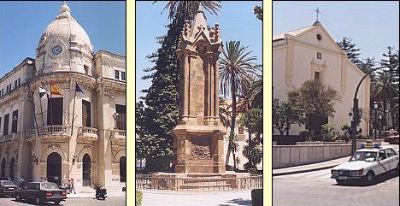
Ceuta, along with Melilla 250 kms further east, is a little bit of Africa that is “forever” Spain.
When Spain handed over northern Morocco to the new kingdom in 1956, they kept this little enclave: the European Union’s own bit of Africa. Spain has controlled it since 1580.
Ceuta is divided into two zones: To the east practically all the inhabitants are Spanish, and the feeling around you is all Spanish. As soon as you head west, coming closer to the border area, you spot the first mosques, the women you see more often wear traditional, conservative, Moroccan clothes. At the border, even on the Spanish side, you have already reached Morocco. Here you find markets where cheap contraband is sold, and then imported to Morocco through the magic of “baksheesh”.

Ceuta is a pretty, very friendly place, known for its duty free shopping, but if you take the time to walk around places like Monte Hacho, there is lots to see.
 Eremitage of San Antonio: Rebuilt in 1960 its architectural style is quite different from the Spanish architecture around it. It is rumored to be the inspiration of the Mexican restaurant right across the road! Eremitage of San Antonio: Rebuilt in 1960 its architectural style is quite different from the Spanish architecture around it. It is rumored to be the inspiration of the Mexican restaurant right across the road!
From here you find great views to Europe and the Spanish Mainland. You see Gibraltar from a different angle too – it looks like it is falling into the Mediterranean Sea.
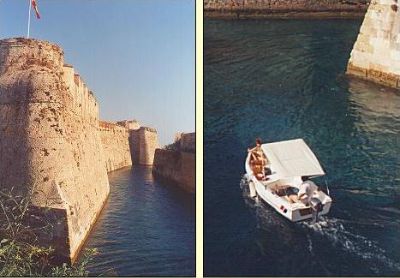 Foso de San Felipe: Right where the Moroccan mountains come to an end, and before Monte Hacho starts to rise, the ruins of the old city walls can be found. Dating from the Almohad period and rebuilt in the 17th Centruy it is now bisected into two parts by a small canal allowing boats to pass right through it. Foso de San Felipe: Right where the Moroccan mountains come to an end, and before Monte Hacho starts to rise, the ruins of the old city walls can be found. Dating from the Almohad period and rebuilt in the 17th Centruy it is now bisected into two parts by a small canal allowing boats to pass right through it.
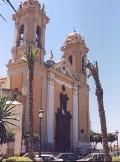
The Cathedral: Building alterations only finished in 1949.
Fortress of Monte Hacho: You can walk around this imposing castle but it is still a military base. You rarely see the soldiers but eerily you can hear them talking.
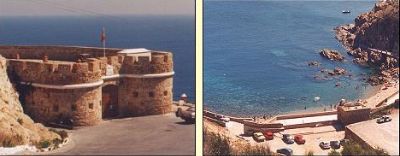 Castillo del Desnarigardo: Walk through a beautiful wood and you come to this picturesque castle, after enjoying the view go done to Ceuta’s only beach. Castillo del Desnarigardo: Walk through a beautiful wood and you come to this picturesque castle, after enjoying the view go done to Ceuta’s only beach.
Franco monument: In a strange twist this little place was the launching point for the invasion of Spain led by Franco July 1936. Unlike in mainland Spain no one has tried to demolish this monument but equally no one takes care of it and it is slowly crumbling but curiously is still highlighted on the tourist maps - a marker of another, less happy time.
How do you visit Ceuta?
To visit Ceuta for a day trip, take a ferry from Tarifa or Algeciras. Tarifa is less than one hour's drive from Casa de Alhambra.
Tickets can be easily bought from roadside stores.

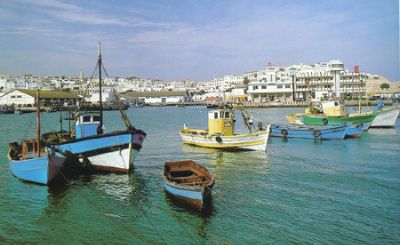
On the southern shore of the Straits of Hercules (now Gibraltar) where Hercules separated Africa and Europe in one of his twelve labours Tangier, the White City, stands at the crossroads of civilisation, where the Mediterranean meets the Atlantic Ocean.
Stroll down alleyways of the Medina or old Arab town containing a pair of picturesque markets : the Grand Socco and the Petit Socco (the Spanish word for "souk"). The medina is a real one with narrow streets, houses in many different styles. As a tip when shopping avoid the fixed price shops as when you haggle you will only get a small reduction and still pay up to 5 times more than elsewhere.
From the "Place de la Kasbah", the highest point in the Medina, you can visit the Dar El Makhzen. This palace, built by sultan Moulay Ismail, is now a museum of art and architecture.
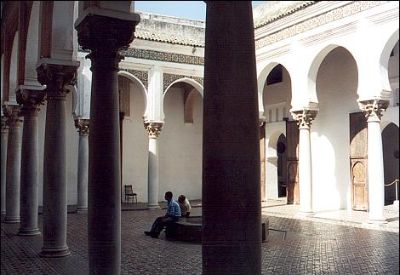
Visit the renowned the Mendoubia gardens, with their eight-hundred-year-old trees, the Sidi Bouabid Mosque, its minaret decorated with multi-hued faiences’ dominating the Medina, the Kasbah Square with its portico of white marble columns, and the great Mechouar where the pashas once ruled.
Close to the medina you can take excursions to Cape Spartel -the extreme north- westerly point of Africa, close to the Caves of Hercules and Cape Malabata.
How do you visit Tangier?
To visit Tangier take a day trip by ferry from Tarifa or Algeciras. The ferry takes just 35 minutes from Tarifa which is only one hours drive from Casa de Alhambra.
Tickets can be easily bought from roadside stores. It may be better to ensure an organised trip if you are to enjoy all the sites in one day.
Medina Sidonia
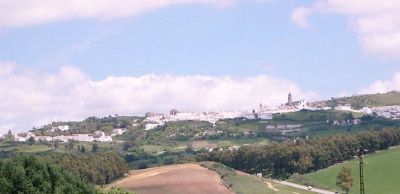
Medina Sidonia is an unspoilt, white hill-top town, which dates back to the Romans. The town was one of Spain's most important ducal seats in the 15th century; producing an admiral who led the Armada against England.
The village has an ancient grandeur with medieval walls and tiny narrow cobbled streets flanked by rows of “Reja”-fronted houses.
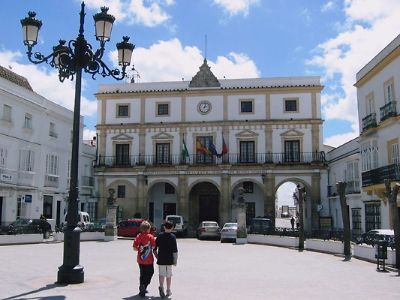
The Plaza de España is an elegant plaza, surrounded by handsome three storey buildings with the 17th century Baroque and Neo-classical Town Hall presiding over the square.
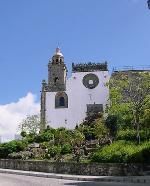
The Church of Santa Maria la Coronadois built on the foundations of the original castle and a mosque. This church is a superb example of Andalusian Gothic architecture. Inside an exquisite 15m high retablo, depicting scenes from the life of Christ is the centre piece. But there is also a fine sculpted image of Cristo del Perdón attributed to Luisa Roldán, and several sixteenth century benches that were used by the infamous Spanish Inquisition.
Medina Sidonia also has three Moorish gates including the magnificent Arco de la Pastora, close to the Jerez road.
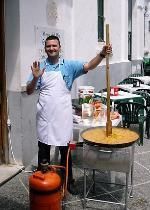
There is a good choice of restaurants and bars located mainly around the Plaza de España offering good local cuisine and tapas. For something a little special, head to El Duque, Paseo Armada Española, which specialises in excellent meat dishes with spectacular views from the terrace.

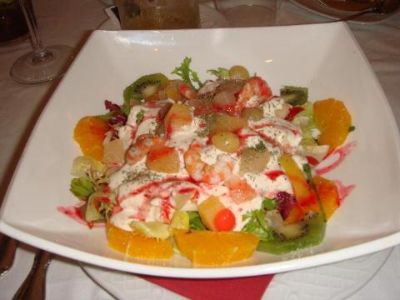





© Copyright Casa De Alhambra Holidays 2004 - 2008
| 
